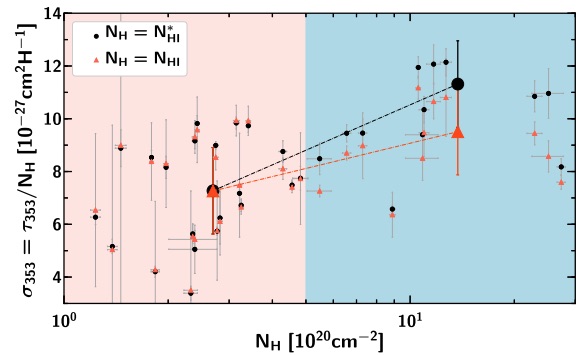Observations of interstellar dust are often used as a proxy for total gas column density N H. By comparing Planck thermal dust data (Release 1.2) and new dust reddening maps from Pan-STARRS 1 and 2MASS, with accurate (opacity-corrected) H I column densities and newly published OH data from the Arecibo Millennium survey and 21-SPONGE, we confirm linear correlations between dust optical depth tau 353, reddening E(B – V), and the total proton column density N H in the range (1-30) × 1020 cm-2, along sightlines with no molecular gas detections in emission. We derive an N H/E(B – V) ratio of (9.4 ± 1.6) × 1021 cm-2 mag-1 for purely atomic sightlines at | b| > 5deg , which is 60% higher than the canonical value of Bohlin et al. We report a ˜40% increase in opacity sigma 353 = tau 353/N H, when moving from the low column density (N H < 5 × 1020 cm-2) to the moderate column density (N H > 5 × 1020 cm-2) regime, and suggest that this rise is due to the evolution of dust grains in the atomic interstellar medium. Failure to account for H I opacity can cause an additional apparent rise in sigma 353 of the order of a further ˜20%. We estimate molecular hydrogen column densities NH2 from our derived linear relations, and hence derive the OH/H2 abundance ratio of X OH ˜ 1 × 10-7 for all molecular sightlines. Our results show no evidence of systematic trends in OH abundance with NH2 in the range NH2 ˜ (0.1-10) × 1021 cm-2. This suggests that OH may be used as a reliable proxy for H2 in this range, which includes sightlines with both CO-dark and CO-bright gas.
Nguyen, Hiep; Dawson, J. R.; Miville-Deschênes, M.-A.; Tang, Ningyu; Li, Di; Heiles, Carl; Murray, Claire E.; Stanimirovic, Snezana; Gibson, Steven J.; McClure-Griffiths, N. M.; Troland, Thomas; Bronfman, L.; Finger, R.
2018, The Astrophysical Journal, 862, 49
http://adsabs.harvard.edu/abs/2018ApJ…862…49N

